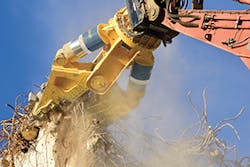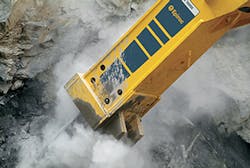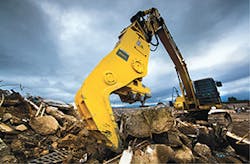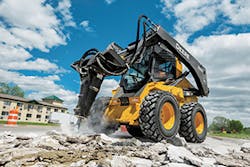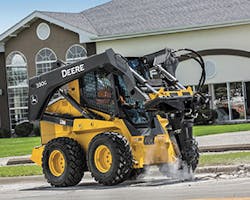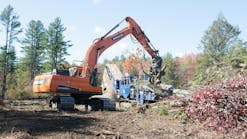Picture this: You’re getting a lot ready for the construction of a new 10-story hotel when suddenly your crawler hits stone.
Or perhaps your underwater excavator hits an old bed of concrete. Or maybe, just as you think you’re ready to move on to the next step of a job, you hit frozen soil.
All of these situations have one thing in common—you’re going to need a hydraulic breaker.
A flexible yet crucial attachment, breakers are used for a wide variety of job sites, including foundation removal, trenching, tunneling, dredging, bridge demolition, material separation, beam cutting, and quarry excavation.
We could go on, but…
“That will be a long list,” says Torsten Ahr, vice president of marketing for the hydraulic attachment tools division for Epiroc, when asked about all the types of jobs that require a breaker.
Breakers, also called hammers, are front attachments for skid steer loaders and excavators that break apart stone, concrete, rebar, or pretty much anything hard that you need to split into smaller pieces. It is, essentially, a jackhammer that attaches to the front of excavation equipment. Other names for hydraulic breakers include peckers, hoe rams, and hoe rammers.
“Hydraulic attachments are an alternative where the ordinary [excavator] bucket cannot fulfill the requirements in terms of rock breaking or concrete crushing,” says Ahr.
Breakers’ powerful chisels break through tough material, and various types of breakers are sold to handle various types of rock and hard materials. The breakers themselves vary in size and weight, depending on the excavator to which they are attached.
“You’d rather have a breaker in your back pocket in those situations where you’re trying to dig and you’re hitting rock,” says Peter Bigwood, sales and marketing manager for Brokk Inc, a demolition equipment company based in Monroe, WA.
When is the best time to use a breaker? Whenever you need to remove large chunks of debris, rock, or other hard material from the ground or a structure without using explosives.
Bigwood says the strategy in prior decades to break up rock before laying a soil foundation was to drill holes in the rock and drop down dynamite. That strategy is still used, but some municipalities forbid the use of explosives. Explosives are often not used near or in urban areas, he says.
In New York City, for example, excavators will hit granite very quickly in Manhattan due to the composition of the island. He says it would be difficult to get the city to allow explosive-based excavation due to concerns about scaring the urban population with an unknown explosion—particularly given the living memory of 9/11.
In addition, he says, blasting isn’t practical in all material removal situations. In addition to scaring passersby, it could damage other nearby buildings, hurt ecosystems, and throw dust into the air. At times, it’s simply not the most cost-effective option for construction crews at that particular moment. Especially if the construction operator already owns a breaker, it can be the best option for long-term use for material removal. Renting a breaker is also an option, experts added, and that can be an option that is friendlier to the bottom line if you only need to use aa breaker one or twice a year.
“People don’t want to be blasting so much if you’re building a subway tunnel under office buildings, for example,” says Bigwood.
That’s where breakers come into play.
The weight of any breaker should be 10% of the weight of the carrier, he says. Picking the right excavator for the breaker, and vice versa, will make a big difference in the efficacy of the breaker and the long-term usability of the machines.
If a contractor had a 10-ton excavator, then they should opt for a 1-ton breaker, he says. Breakers don’t need to be huge, though. A 1,500-pound skid steer would only need a 150-pound breaker, and so on. As long as the 10% rule applies, the choice of breaker can be scaled up as needed for various job needs.
When choosing a breaker, you should examine the technical specifications of the breaker you’re looking to buy. The size, power, make, model, tool, and other aspects are all important and can vary based on the job you’re trying to do.
The oil flow statistics, given in a range of liters per minute, will give you an estimate of how quickly the hydraulic oil will flow through the piston while the breaker is in motion. The operating pressure shows how much pressure is necessary to run the breaker before a relief setting needs to be added in to prevent overheating.
The impact rate, provided in blows per minute, will vary based on the size of the breaker. Smaller breakers will have more blows per minute, but those blows will be weaker than larger breakers.
A breaker is made up of several parts, including the piston, the tool, the housing, rock claws or draggers, energy chamber, and hydraulic valves.
The hydraulic oil builds up inside the energy chamber until it reaches a maximum point and forces the piston below it downward, hitting the drilling tool. The outside casing protects the parts from getting contaminated by dust and dirt from the job site, and proper maintenance can ensure that hydraulic oil isn’t leaking from the breaker, compromising the part and slowing down drilling speed.
Bigwood says in order for a breaker to work properly, certain aspects need to be considered, such as hydraulic pressure and downward force.
The Epiroc HB 1000 hydraulic breaker at work
Having enough hydraulic pressure will make it possible for hydraulic oil to flow from the carrier to the breaker, and it’s necessary to check those hoses regularly for grit and to change the oil on a regular preventative maintenance schedule to elongate the life of your breaker.
If the hydraulic oil gets backed up, Bigwood says, then that can create excess back pressure on the breaker. If that happens, the hydraulic oil might be forced back through the hose and into the carrier, which creates damaging leaks and backups.
How bad can excess back pressure really get? Imagine ants rushing into a small opening of an anthill all at once, bursting the hole wider—except the ants are your oil and the anthill is your valuable machinery. It’s important to keep back pressure low, he says, to keep hydraulic oil flowing through the breaker at a measured rate.
Downward force is another consideration, Bigwood says. As the chisel is being slammed by the piston, there needs to be enough weight behind the breaker to actually split the rock. If there isn’t enough weight, the energy of that blow won’t get passed onto the rock.
The drill tool itself won’t be able to pierce the rock without the necessary force, so the drilling tool will just bounce off the still-intact rock without that downward force.
The Epiroc BP 2050 bulk pulverizer
Typically, the weight of the excavation arm will be enough to achieve this force. But operators will also know how to push their machine to achieve more force and sometimes a skid steer will rear up on the front two wheels after a successful blow. This also varies based on the size of the breaker, size of the excavator, and size and density of the rock you’re trying to break. A concrete road will give much easier than solid granite bedrock, after all.
Some jobs, like demolishing a ceiling or a tall wall, will require some extra force and some deft maneuvering by the operator to achieve the energy needed to crack the concrete.
It’s also a good idea to consider the type of material at each job site because various materials will need different tools to achieve the results you want, says Jessica Hill, program manager of global attachments at John Deere Construction & Forestry.
“Our hydraulic hammer models have different tips that can be used for drilling through various types of material,” she says. “For example, our spade and chisel point tips are ideal for general concrete drilling work, whereas our moil tip is ideal for material with medium hardness, like limestone. Our compacting tip is ideal for dirt in job site preparation.”
Breakers were invented as a step up from pile drivers. Mechanized pile drivers were made possible by the discovery of oil as a fuel source, which prompted the Industrial Revolution. The advent of technologies like hydraulics, pneumatics, and diesel fuel set the stage for the invention of breakers, according to Hydraulic Breaker Services.
Early forms of breakers used nitrogen and other fuels as their tool-driving force, and hydraulic breakers came along about 50 years ago, invented by Atlas Copco, the company states. While the public might look at an excavator and a hydraulic breaker and not see the connection, breakers actually owe their existence to academia.
Hydraulic breakers rely entirely upon the theory of fluid mechanics to work. This branch of physics harkens all the way back to ancient Greek philosopher Archimedes and his investigation of fluids at a time when the Roman Empire spread across modern-day Europe.
As scientists better understood fluid dynamics—the branch of fluid mechanics that looks at how fluids flow—commercial uses for thick liquids were finally invented. Being able to predict the temperature, pressure, velocity, and density of a viscous fluid—like hydraulic fluid—made it possible to create machinery like hydraulic breakers.
The same field of study that made it possible to fly a plane, predict the weather, and understand water currents made breakers—and all hydraulic technology—a reality today.
Demolition sites are as efficient as they are today because of increasing research and development at company labs, but without mathematicians and physicists, breakers would be stuck in the world of science fiction.
But the future of hydraulic breakers is already touching today’s industry.
The efficiency of hydraulic breakers has improved over the past roughly 50 years, and better and lighter casing, faster pistons, harder drilling tools, and simply bigger breakers have reached the market year after year.
“They are certainly changing all the time to match the needs of applications and productivity increase,” says Ahr. “For instance, our hydraulic breakers are getting lighter but deliver the same performance as their heavier predecessors. That means a lower investment in the breaker and the carrier as well as less fuel consumption, but still a high productivity.”
Hill says the improvements seen across the industry help operators get their jobs done faster, better, and with fewer mechanical failures. Less time fixing breakers means everyone gets home sooner.
“Even compared to five years ago, our hydraulic hammer designs have been refined to better serve our customers. We’ve been really focused on reducing job site downtime and increasing attachment productivity,” she says.
She says John Deere has been rolling out breakers that use fewer parts, which makes the breakers lighter and easier to fix. This decreases the necessary maintenance training time, decreases the equipment downtime, and decreases the likelihood that a maintenance issue will turn into a full-blown issue that requires significant work or replacement.
“Our new HH20C, HH40C, HH60C, and HH80C models have a redesigned tubular-shaped membrane, which reduces the need for frequent nitrogen recharges,” says Hill. “These designs also feature 30% fewer parts, making it easy for owners and operators to perform simple maintenance with just a screwdriver. Our hammers also offer two to three times more blows per minute (BPM) than previous models for increased efficiency, making them the fastest on the market to help operators power through tough material.”
Where are breakers going in the next five, 10, 15, or even 50 years?
First of all, it’s best not to recreate the wheel, experts say. Making their current offerings faster, more powerful, lighter, and easier to maintain is a key element of the future of breakers.
“We’re always looking at ways to improve the reliability and efficiency of our attachments,” says Hill. “This includes looking at new materials to make our attachments more durable and new designs to make them faster and require fewer parts. Ultimately, we want our customers to have more powerful and more affordable attachment options, with lower daily operating and maintenance costs.”
Ahr says the industry is increasingly focused on automatic options for elements of the breaker.
“We are adding more and more features that change the machine settings automatically depending on the material hardness, for instance,” he says.
He says Epiroc’s hydraulic breakers have a protection system that can change the length of the stroke of the piston as the contact pressure between the chisel and the material it’s breaking increases.
“At that time [the breaker] changes into the AutoStop mode, which shuts off the breaker and prevents it from blank firing, when the chisel breaks through the material,” he says. “That makes breaking simpler, faster, and increases uptime due to less wear in the machine.”
Blank firing can cause a host of issues to the breaker and operators typically try to avoid blank firing for significant periods of time, or else the breaker will likely need extra maintenance due to that added stress.
Christian Yanes, president for North America at Steelwrist, says attachments can also be adjusted with additional tools such as quick couplers and tilt rotators. Tilt rotators are more common in European countries and typically used for landscaping projects, and they aren’t recommended with breakers and sheers due to the excess pressure. Quick couplers are used with a wide range of attachments including breakers and sheers.
A John deere 332G skid steer getting use out of
a HH60C hammer
Tilt rotators perform as the name suggests: they tilt and rotate attachments. Before the creation of tilt rotators about 30 years ago, operators had to move their excavator whenever they wanted to dig in a different area.
“In tight places, like let’s say downtown Manhattan, the machine doesn’t have a lot of movability because there’s traffic, there are people,” says Yanes. “Without moving the machine, you’re able to do the same job.”
Quick couplers, such as Steelwrist’s newest automated unit, can automatically attach and detach attachments so an operator doesn’t have to switch machines every time he or she needs a new attachment.
Yanes says his company’s latest quick couplers use proprietary technology to automatically attach and detach hydraulic hoses and electronics on attachments, saving contractors time, stress, and the cost of buying multiple machines.
“The operator can change attachments without having to get off the machine because the hydraulics engage at the same time when he engages the attachment,” he says. “It saves significant time and aggravation … when you’re trying to get these lines connected.”
Automated lubrication systems have also improved some modern-day breakers. Automatic lubrication provides a specific amount of lubrication throughout the workday, eliminating the need for routine stops to replace and recheck the lubrication within the breaker. Some automatic systems provide the operator with a gauge that shows how much lubrication is left so they can appropriately judge when to refill the lubrication system.
Another innovation, dust suppression systems, helps operators and maintenance staff avoid costly downtime from dust and grit entering the hydraulic oil system. Some operations, such as drilling away at rock walls, kick up significant dust, rock, and dirt into the air around the excavator and breaker. While regular cleaning and maintenance prepare for this inevitable onslaught of grit, dust suppression systems help provide some preventative action.
Certain types of dust and grit can also be a health and safety hazard on job sites. Silica exposure can cause silicosis, an occupational hazard disease that is irreversible and causes damage to the lungs. The damage can be so severe that patients can require a lung transplant or could die, according to the US Centers for Disease Control and Prevention. There were 84 deaths nationally due to silicosis in 2014, the most recently available data on the disease.
Set in a square frame around the body casing of the breaker, the dust suppression system squirts out a steady mist of water around the drill tool. This prevents dust from the broken up material from entering the breaker and clogging the inner parts, which can be damaging, especially to the hydraulic system.
Newer breakers also have additional features that limit user error and make training simpler, Bigwood says. Between protections against dry firing that are common in modern breakers, better quality chisel paste, and automatic lubrication, breakers are faster and more efficient than ever, he says.
The future of breakers is even more fantastic. Remote-controlled robotic breakers have begun to enter the market, both on medium- to large-sized excavators and smaller indoor breakers, Bigwood says, noting his company Brokk sells remotely controlled demolition machines.
The smallest robots in his company’s fleet boast the ability to “walk” up and down staircases and can hammer inside hallways for confined demolition or renovations. Remote breakers, in general, are able to work in toxic environments or areas without much light.
A John Deere 330G gets to work with an
HH60C hammer
Bigwood says robotic breakers can be programmed for exact efficiency—everything from the lubrication to the speed to the impact strength. While a skilled human operator might only be at peak efficiency a portion of the time, a robotic breaker can provide the ideally efficient environment for the breaker—but it still requires the expertise of an operator to control it and requires the experience of highly skilled maintenance and repair teams to keep it operational.
“The demolition robot would smoke the bobcat with the identical hammer,” he says. “The demolition robot every time would smoke it because it’s giving the hammer exactly what it wants. The reality is the losses in the system due to friction, heat, noise, all of those things combined rob the hammer of its efficiency. Even the best hammers…are probably running at about 60% efficiency.”
Bigwood says robotic breakers are excellent for indoor work, but they’re “not really necessary” for outdoor work because space isn’t a limiting issue.
So fear not—these robots are great supplements, but not a replacement to current fleets. The time has not yet come where breakers and excavators can autonomously operate job sites, but current innovations on breakers could make it possible to clean up complex, dangerous sites that no human could safely navigate without breaking workplace hazard laws.
With the advent of artificial intelligence (AI) and the integration of AI into robotics, it may be only a matter of time until autonomous excavators with attached breakers wheel into a job site near you, waiting for the foreman’s instructions via smart connected tablet. These innovations could free up workers to do more complex jobs on site, jobs that are not routine enough to be pre-programmed.
While there is concern within the construction industry about the impact automation and artificially intelligent machines will have on the job prospects within the construction industry, the construction industry is also facing a worker shortage in the next few decades—making it less likely that qualified, eager employees will be left without job offers.
And, perhaps one day, today’s technology will be referenced as the grandfather of technology that allows us to mine or build on the Moon, Mars, or an asteroid. It may seem far-fetched, but after all, today’s breaker innovations would seem so strange to users of the first mechanical piledriver.